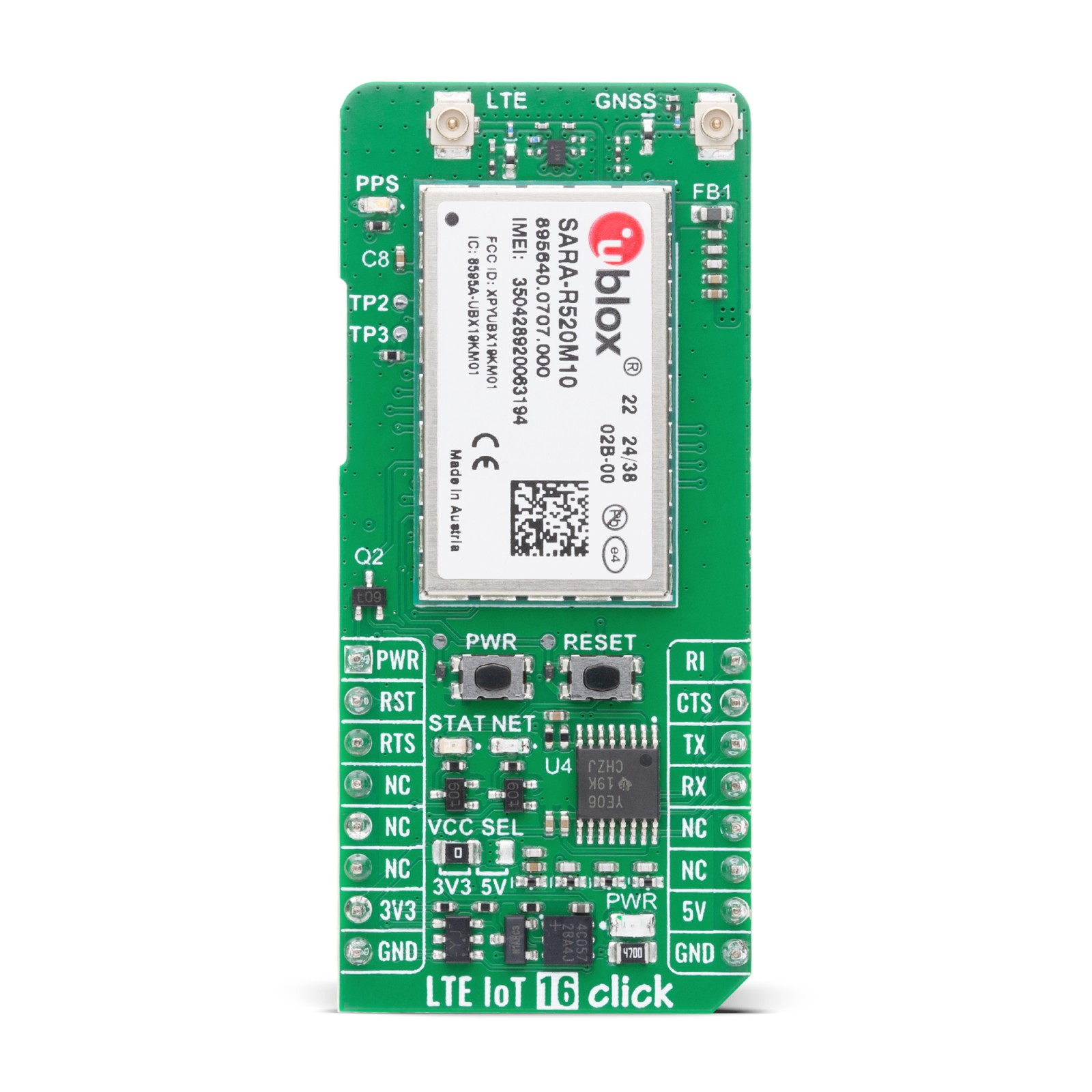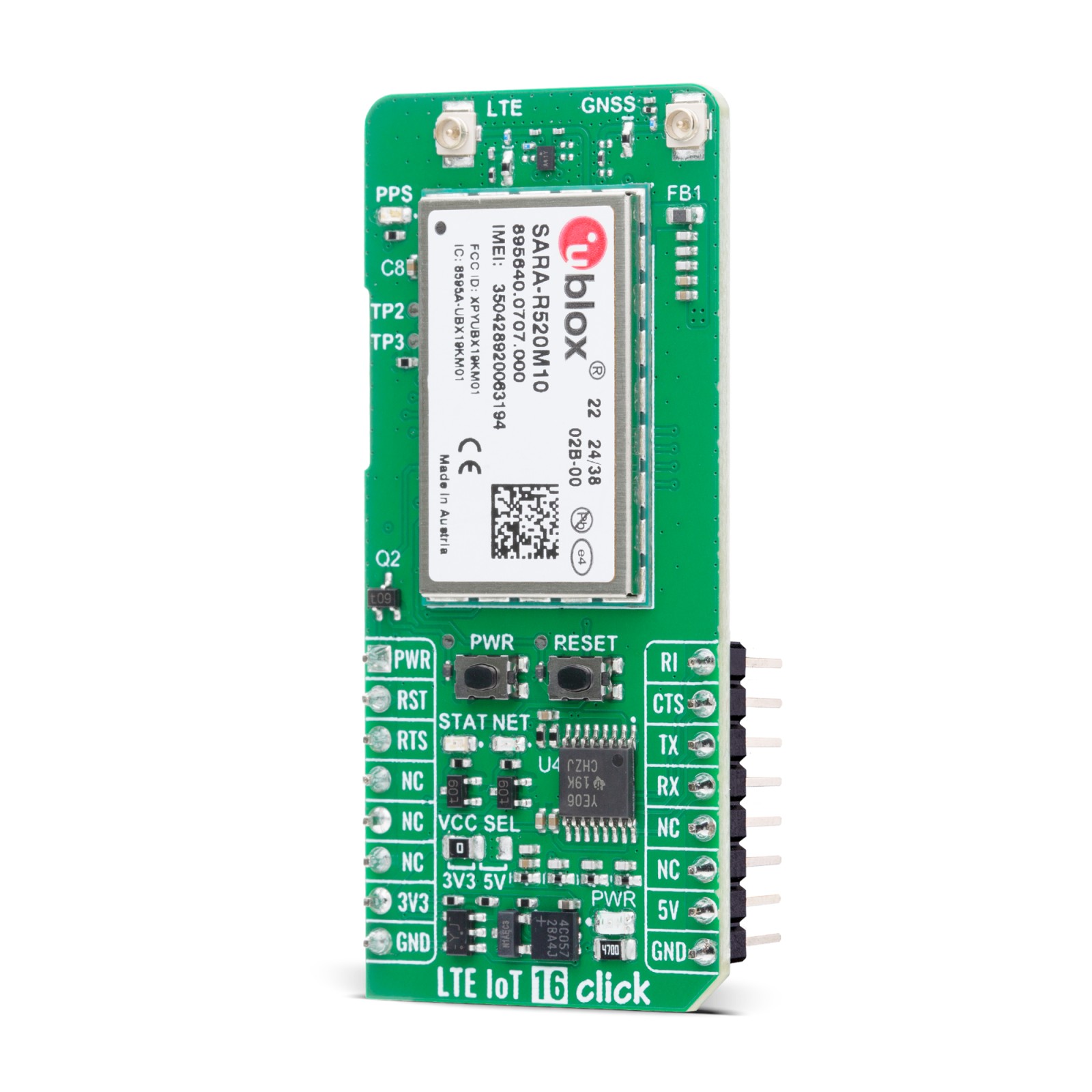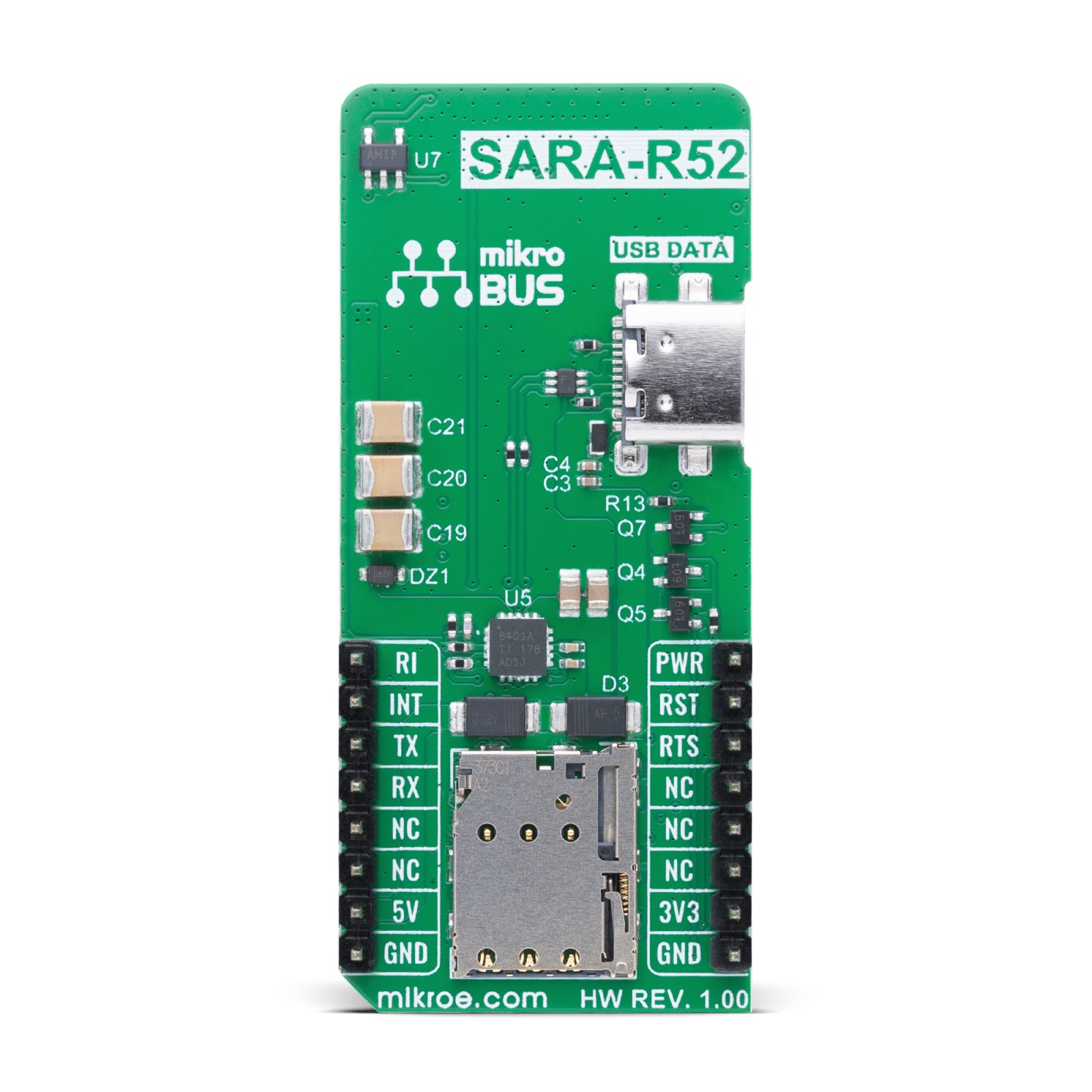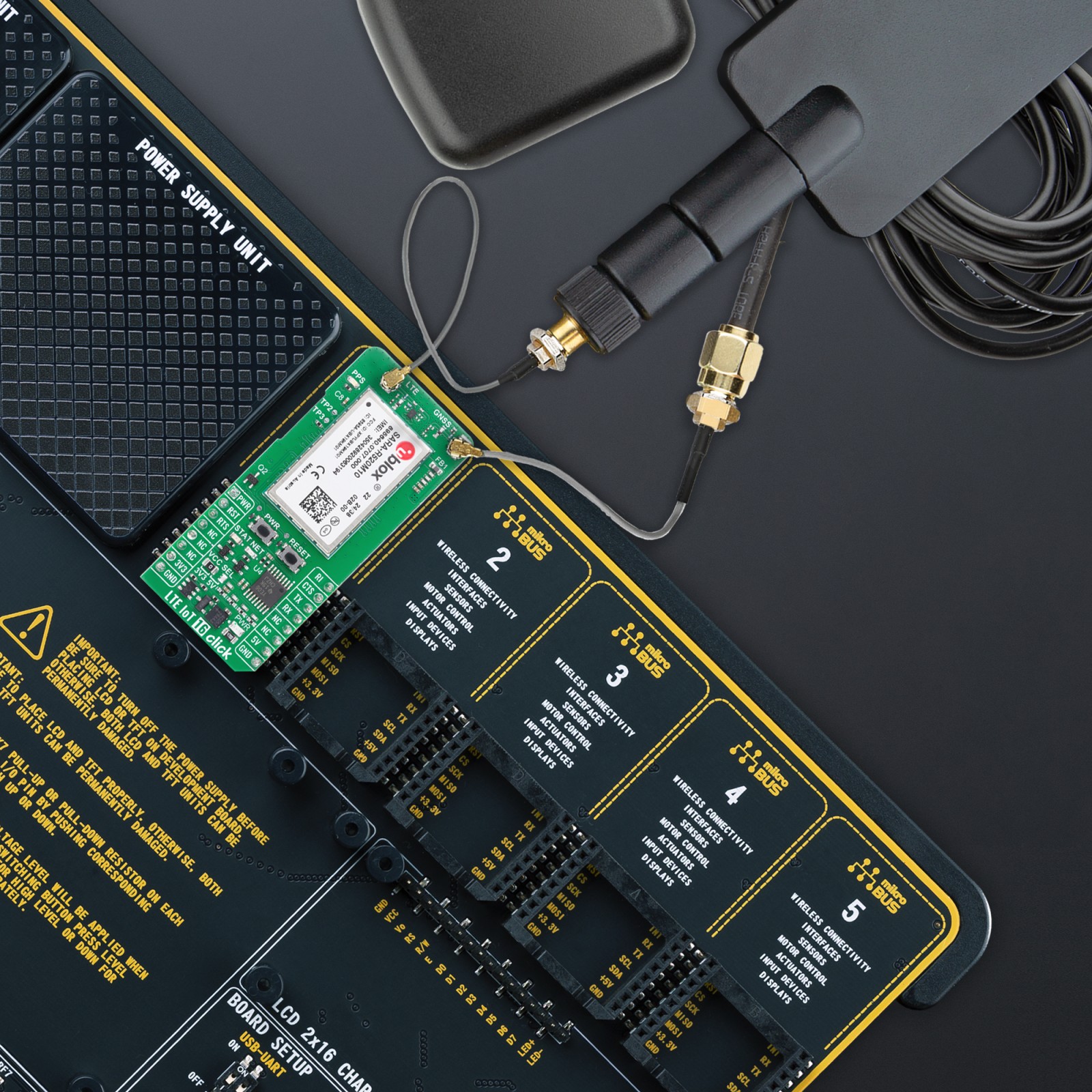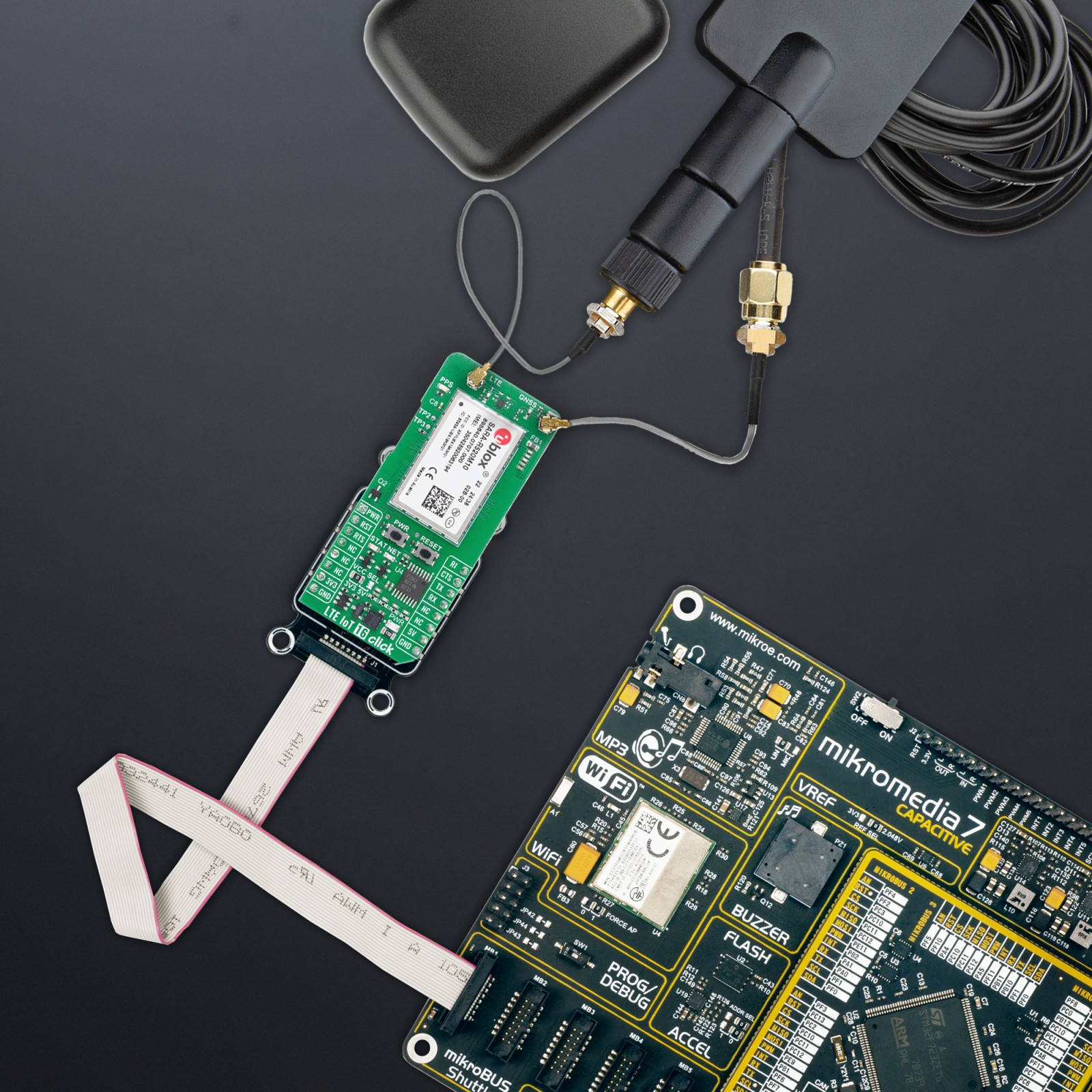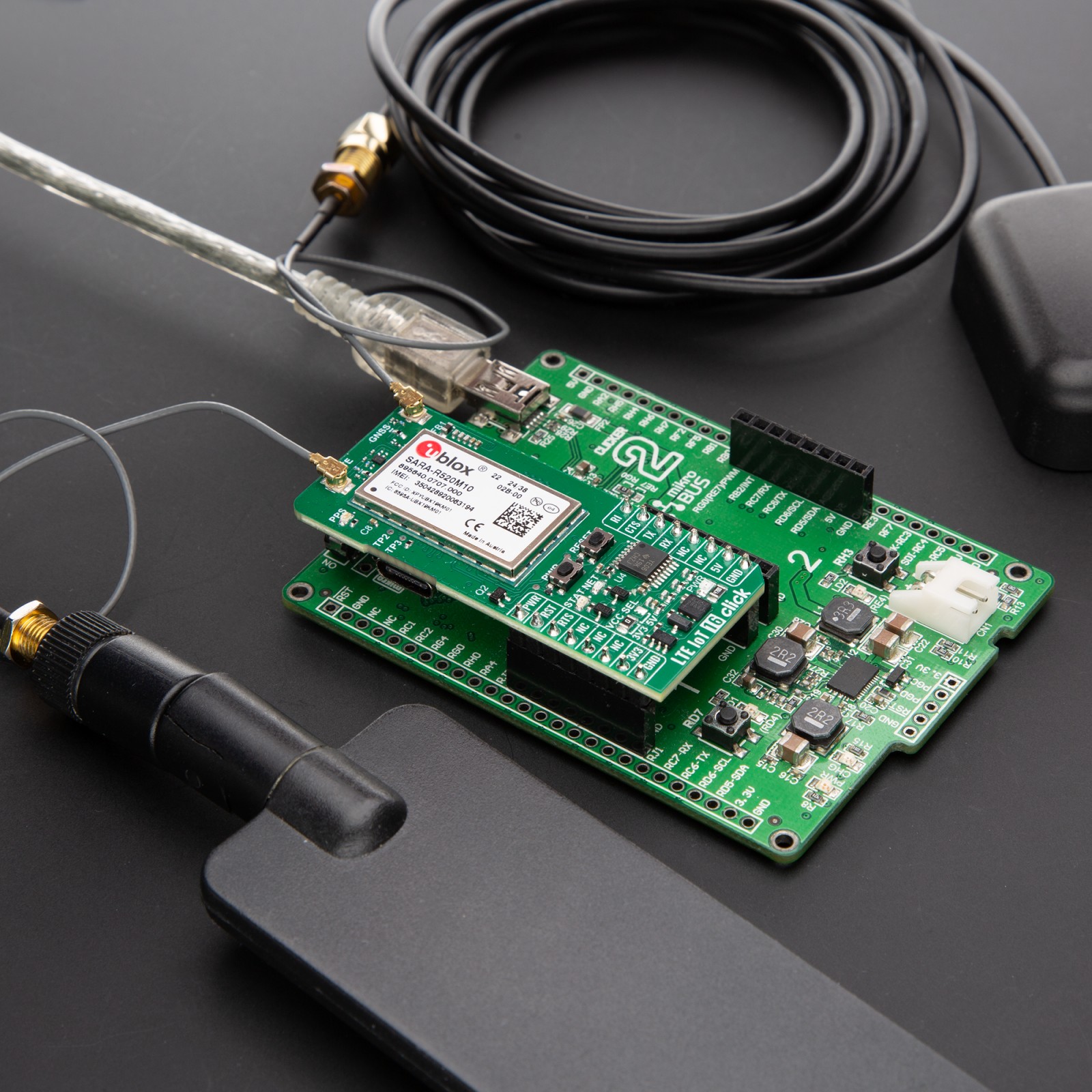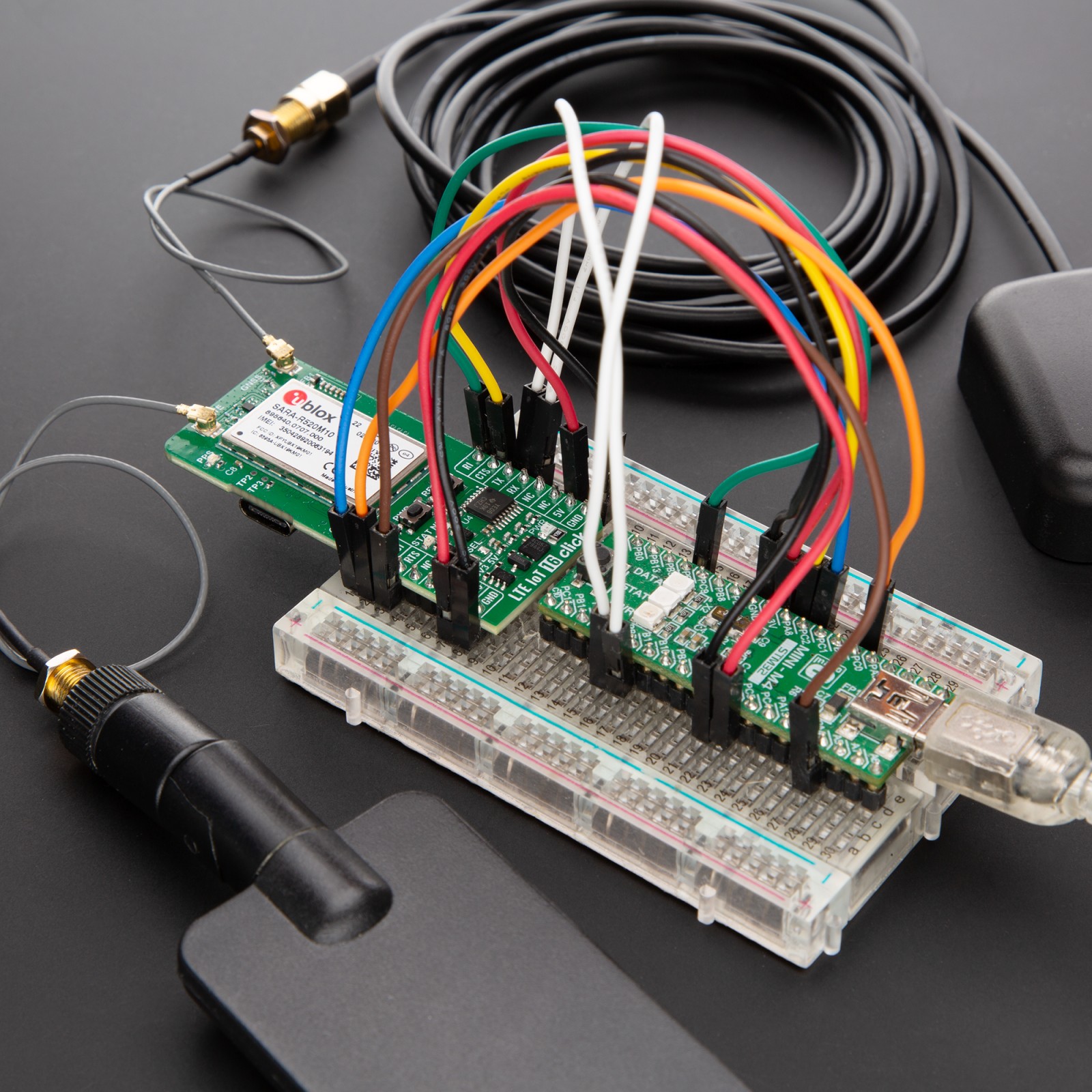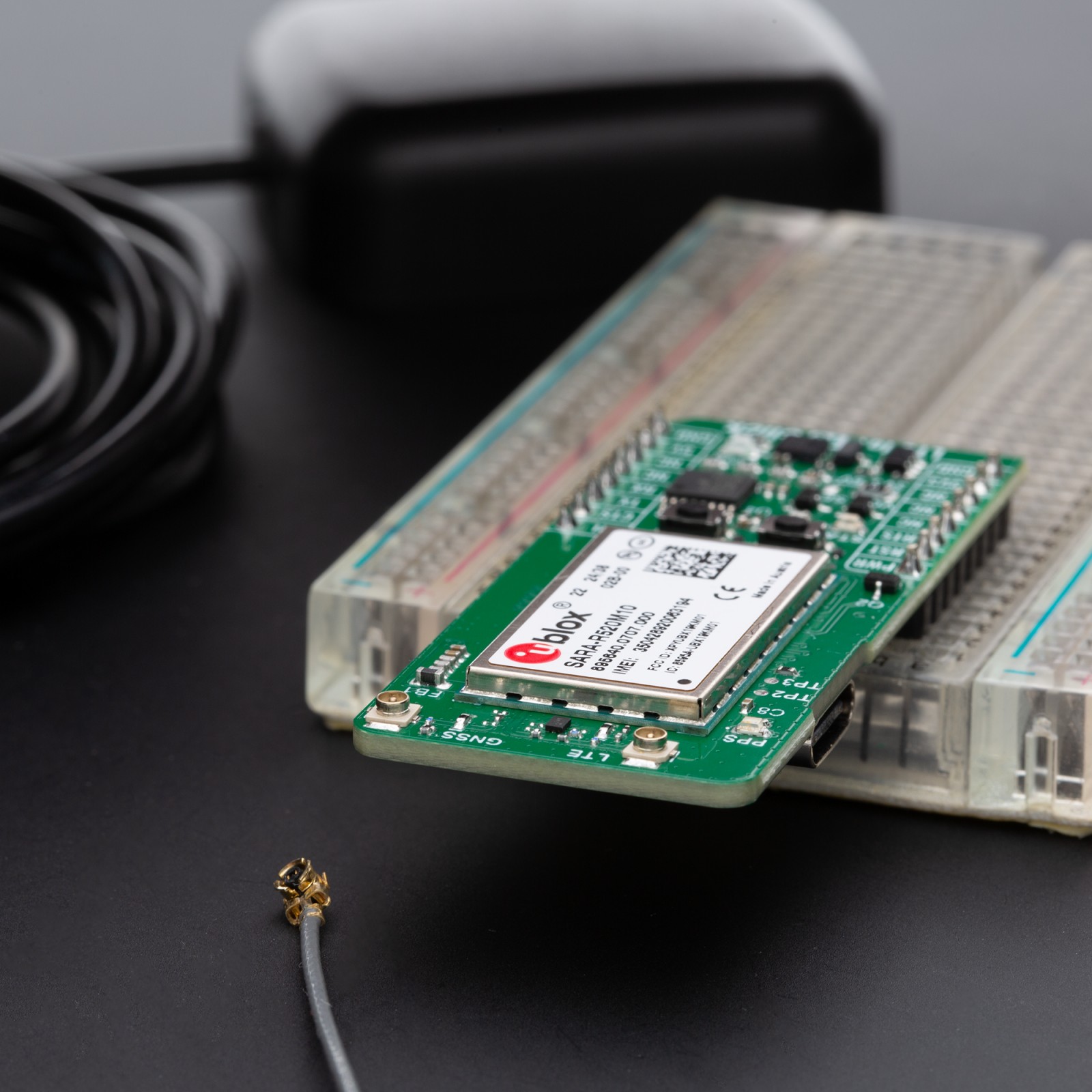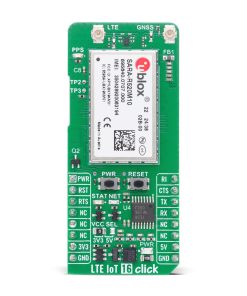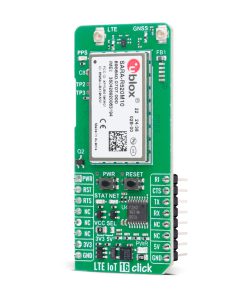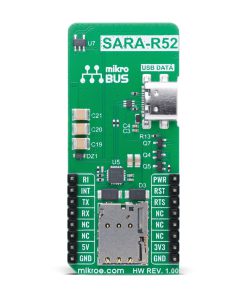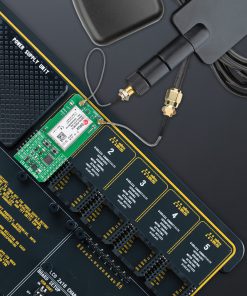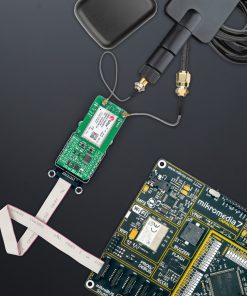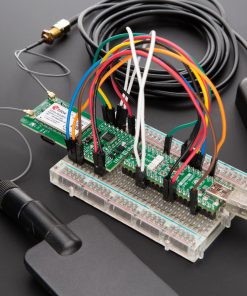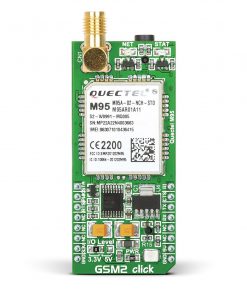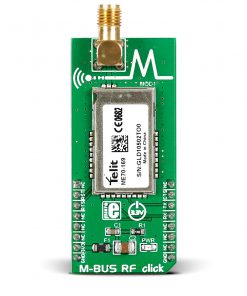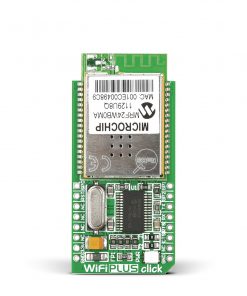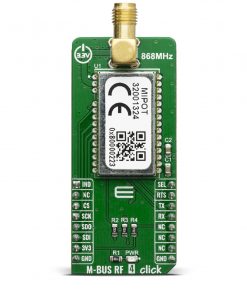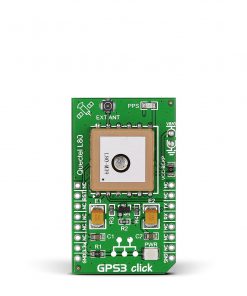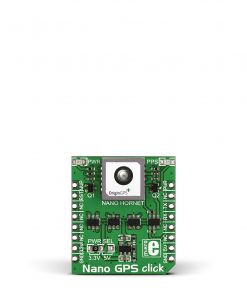Subtotal: R130.00
LTE IoT 16 Click
R1,900.00 ex. VAT
LTE IoT 16 Click is a compact add-on board designed for cellular connectivity and GNSS-based positioning in IoT applications. This board features the SARA-R520M10 module from u-blox, part of the SARA-R52 series. Supporting LTE Cat M1 and NB2 across multiple global bands, it combines low power consumption with enhanced data rates and integrated u-blox M10 GNSS for accurate location tracking. The board features UART and USB interfaces, power and reset control, dual antenna support, micro SIM compatibility, and robust security features including secure boot and cloud service certifications. Ideal for asset tracking, smart metering, remote monitoring, and location-based services.
LTE IoT 16 Click is fully compatible with the mikroBUS™ socket and can be used on any host system supporting the mikroBUS™ standard. It comes with the mikroSDK open-source libraries, offering unparalleled flexibility for evaluation and customization. What sets this Click board™ apart is the groundbreaking ClickID feature, enabling your host system to seamlessly and automatically detect and identify this add-on board.
Stock: Lead-time applicable.
| 5+ | R1,805.00 |
| 10+ | R1,710.00 |
| 15+ | R1,615.00 |
| 20+ | R1,554.20 |
How does it work?
LTE IoT 16 Click is based on the SARA-R520M10, an LTE-M and NB-IoT module from the SARA-R52 series from u-blox. Built on the second generation of u-blox’s in-house UBX-R52 cellular chipset and featuring the integrated u-blox M10 GNSS receiver, this module is made for high-performance global IoT applications. It supports LTE Cat M1 and LTE Cat NB2 connectivity over a wide range of bands (1, 2, 3, 4, 5, 8, 12, 13, 18, 19, 20, 25, 26, 28, 66, 71, 85) and incorporates key features from 3GPP Release 14 and Release 15, ensuring enhanced coverage, improved data rates, low power consumption, and reliable mobility. With an LTE transmission power of 23dBm, the SARA-R520M10 guarantees robust and stable cellular communication. Integrated with the u-blox M10 GNSS chip, this module is capable of delivering precise and concurrent positioning data alongside LTE connectivity, making it a perfect fit for applications that require continuous or periodic location tracking.

The onboard SpotNow feature further enhances its versatility by offering low-power positioning directly through the UBX-R52 chipset, eliminating the need for a separate GNSS receiver in occasional tracking scenarios. Security is a cornerstone of the SARA-R52 series, offering secure boot, secure updates, and protected production processes. Moreover, it supports u-blox’s MQTT Anywhere and MQTT Flex services, optimizing communication by reducing data overhead and on-air time, which in turn minimizes energy consumption and extends device lifespan. To top it off, the SARA-R520M10 is both AWS IoT Core qualified and Microsoft Azure certified, allowing integration into cloud-based IoT ecosystems.
Communication between the SARA-R520M10 and the host MCU is made through a UART interface, using standard UART RX and TX pins and hardware flow control pins (CTS/RTS/RI – Clear to Send/Ready to Send/Ring Indicator) for data transfer. The module defaults to a communication speed of 115200bps, allowing for data exchange over AT commands. This Click board™ also includes a USB Type C connector for both power and data transfer, which is compliant with the USB 2.0 specification (for diagnostic purpose only).
The LTE IoT 16 Click includes several additional functionalities that enhance its usability and control. The PWR button allows users to easily power the module ON or OFF, while the RESET button provides a quick way to reset the module. These functions can also be controlled digitally via the mikroBUS™ pins PWR and RST, offering greater flexibility. Moreover, these controls have dedicated test points for easier debugging and testing. The board also features some visual indicators to provide real-time status updates.
The first red NET LED indicates the current network status of the module like when the device has successfully registered on the network, has not yet registered to a network, or signals when data transmission occurs. When the LED is completely OFF, it indicates that the device is either powered OFF or in Power Saving Mode. The second yellow STAT LED indicates the module’s status; power-off or deep-sleep mode versus idle, active or connected mode. And the third is a blue LED that displays the timepulse signal (PPS), offering precise time synchronization for applications that require it.
The board features two u.Fl connectors for main LTE and optional GNSS antennas that MIKROE offers, like the LTE Flat and GPS Active antenna combined with an IPEX-SMA cable for flexible and efficient connectivity options. The board is also equipped with a micro SIM card holder that supports both 1.8V and 3.0V uSIM cards, ensuring compatibility with a wide range of cellular networks and allowing users to select the most appropriate service provider for their particular use case.
This Click board™ can operate with both 3.3V and 5V logic voltage levels selected via the VCC SEL jumper. Since the SARA-R520M10 module operates at 3.8V, logic-level translator, the TXB0106, is also used for proper operation and an accurate signal-level translation. This way, both 3.3V and 5V capable MCUs can use the communication lines properly. Also, this Click board™ comes equipped with a library containing easy-to-use functions and an example code that can be used as a reference for further development.
Specifications
Type
LTE IoT
Applications
Ideal for asset tracking, smart metering, remote monitoring, and location-based services
On-board modules
SARA-R520M10 – LTE-M and NB-IoT module from u-blox’s SARA-R52 series
Key Features
LTE-M and NB-IoT connectivity, integrated u-blox M10 GNSS receiver, support for multiple LTE bands, low power consumption, MQTT Anywhere and MQTT Flex service compatibility, AWS IoT Core qualified, Microsoft Azure certified, UART and USB communication interfaces, micro SIM card holder with 1.8V/3.0V support, and more
Interface
UART
Feature
ClickID
Compatibility
mikroBUS™
Click board size
L (57.15 x 25.4 mm)
Input Voltage
3.3V or 5V
Pinout diagram
This table shows how the pinout on LTE IoT 16 Click corresponds to the pinout on the mikroBUS™ socket (the latter shown in the two middle columns).
Onboard settings and indicators
| Label | Name | Default | Description |
|---|---|---|---|
| LD1 | PWR | – | Power LED Indicator |
| LD2 | NET | – | Network Activity Status LED Indicator |
| LD3 | STAT | – | Module Operational Status LED Indicator |
| LD4 | PPS | – | Time Pulse LED Indicator |
| JP1 | VCC SEL | Left | Power Voltage Level Selection 3V3/5V: Left position 3V3, Right position 5V |
| T1 | PWR | – | Module Power-ON Button |
| T2 | RESET | – | Module Reset Button |
LTE IoT 16 Click electrical specifications
| Description | Min | Typ | Max | Unit |
|---|---|---|---|---|
| Supply Voltage | 3.3 | – | 5 | V |
| LTE Frequency Range | 617 | – | 2200 | MHz |
| LTE Output Power | – | +23 | – | dBm |
| LTE RX Sensitivity | – | -107 | – | dBm |
| GNSS Frequency Range | – | 1575.42 | – | MHz |
| GNSS TTFF (Cold Start) | – | 28 | – | sec |
| GNSS Tracking Sensitivity | – | -167 | – | dBm |
Software Support
LTE IoT 16 Click demo application is developed using the NECTO Studio, ensuring compatibility with mikroSDK‘s open-source libraries and tools. Designed for plug-and-play implementation and testing, the demo is fully compatible with all development, starter, and mikromedia boards featuring a mikroBUS™ socket.
Example Description
Application example shows device capability of connecting to the network and sending SMS or TCP/UDP messages, or retrieving data from GNSS using standard “AT” commands.
Key Functions
lteiot16_cfg_setupThis function initializes Click configuration structure to initial values.lteiot16_initThis function initializes all necessary pins and peripherals used for this Click board.lteiot16_set_sim_apnThis function sets APN for sim card.lteiot16_send_sms_textThis function sends text message to a phone number.lteiot16_cmd_setThis function sets a value to a specified command of the Click module.
Application Init
Initializes the driver and logger.
Application Task
Application task is split in few stages:
- LTEIOT16_POWER_UP:
Powers up the device, performs a device factory reset and reads system information.
- LTEIOT16_CONFIG_CONNECTION:
Sets configuration to device to be able to connect to the network (used only for SMS or TCP/UDP demo examples).
- LTEIOT16_CHECK_CONNECTION:
Waits for the network registration indicated via CEREG command and then checks the signal quality report (used only for SMS or TCP/UDP demo examples).
- LTEIOT16_CONFIG_EXAMPLE:
Configures device for the selected example.
- LTEIOT16_EXAMPLE:
Depending on the selected demo example, it sends an SMS message (in PDU or TXT mode) or TCP/UDP message or waits for the GPS fix to retrieve location info from GNSS. By default, the TCP/UDP example is selected.
Application Output
This Click board can be interfaced and monitored in two ways:
- Application Output – Use the “Application Output” window in Debug mode for real-time data monitoring. Set it up properly by following this tutorial.
- UART Terminal – Monitor data via the UART Terminal using a USB to UART converter. For detailed instructions, check out this tutorial.
Additional Notes and Information
The complete application code and a ready-to-use project are available through the NECTO Studio Package Manager for direct installation in the NECTO Studio. The application code can also be found on the MIKROE GitHub account.
Resources
Downloads
| Weight | 22 g |
|---|---|
| Brand | MikroElektronika |

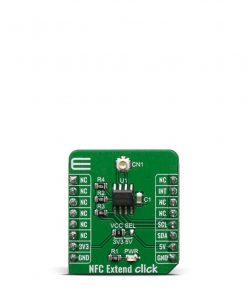 NFC Extend Click
NFC Extend Click 